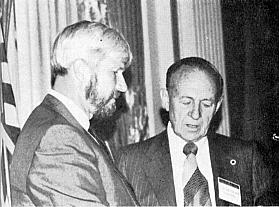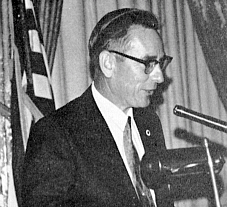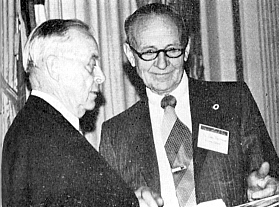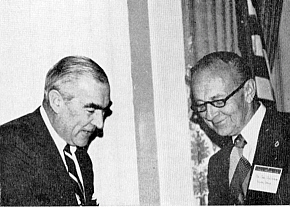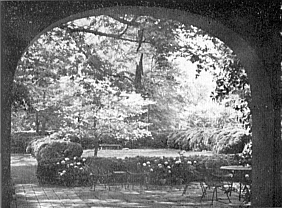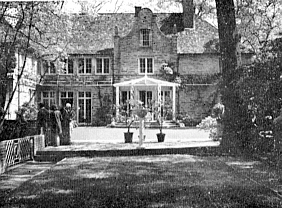QBARS - v25n3 President's Report, Annual Meeting, 1971
ANNUAL MEETING, A.R.S., 1971, PHILADELPHIA, PENN.
Carl H. Phetteplace, M.D.
|
|
|||||
|
|
|||||
| All photos by P. H. Brydon | ||||||
You will recall that the New York Chapter hosted the annual meeting at Planting Fields in 1965. A month or so before the meeting I received a letter from Dr. John Wister inviting me to come on down to Swarthmore after the meeting to visit them. At the close of the New York meeting, many of you will recall that John and Dorothy Knippenberg gave a delightful luncheon and garden tour at their beautiful place on Pines Lake, New Jersey. John and Gertrude Wister were there and we were soon off in their trusty Packard which John, I hear, has used so much to haul plants over the years.
Next morning John gave me a choice of two or three things we might do that day that would be most interesting to me. One choice was that of driving out to see Joseph Gable at Stewartstown. This prospect excited me to the point that I did not consider the distance nor imposition on my host of driving 125 miles there and back in one day. It was a beautiful morning. Mrs. Wister packed a nice lunch for us to eat on the way and we arrived at our destination in the early afternoon to find this gentle, quiet man, Joseph Gable, working among his rhododendrons. Here I was in this famous garden, walking about with two men whom I have long regarded as among the greatest men in all American horticulture. I could not help but wonder how this quiet, unassuming man, Joe Gable, had achieved under certainly not the most favorable conditions in the world all he had contributed to us in the field of rhododendrons and azaleas. Surely there was no evidence of affluence or staffs of workers or subsidies here that I could see. I had the pleasure of meeting some of his family and from their interest and evident knowledge I judged that they must have contributed much to the great accomplishments of Joseph Gable. just as I think Gertrude Wister must have been a great source of help to Dr. John Wister in his busy life making outstanding contributions to almost every horticultural society in existence.
I wonder if I might ask all of you to rise and stand for a moment in salute to these great members of your chapter, the Gables and the Wisters. Before resuming your seats may I ask you to please remain standing to express quite a different emotion. Along with our happiness and good fellowship of these meetings we are almost always reminded of some sadness. At Pine Mountain two years ago I met and visited with your chapter president, John Schamenek. I was much impressed with his warm friendliness and sound thinking. It was a shock to all of us to hear of his untimely and unexpected death. More recently another of our most valued members, Mr. Henry Yates of the Middle Atlantic chapter. died unexpectedly and at a time in life when he still had much to give. Still more recently out on the West Coast we have news of the passing of Lester Brandt. There are few gardens on the West coast which do not grow some of the hybrids he has developed out of the scores of thousands of crosses he made. Such men as these three do not come often. May I ask you to bow your heads for a few moments in silent meditation of sympathy for their loved ones left behind, and for our gratitude for haying had the treasured gifts that these men through their good works have given us.
At this point I wish to express on behalf of the members of the Board and the Society our thanks and appreciation to the Philadelphia Chapter, its members, and the collaborating Princeton and Valley Forge Chapters for putting on this excellent meeting for us who have come to visit you. Also our gratitude must be heartily expressed to Mrs. Ernesta Ballard and the Pennsylvania Horticultural Society for the very substantial assistance in this effort. The meeting regretfully, was dropped into your hands on short notice. It has been a fine meeting, which should give you a sense of deep satisfaction, and we are most grateful for your excellent response.
|
|
I cannot pass without telling you how important a function your Alfred Martin has played, week in and week out, as Eastern Vice-President. Creating this office and being able to get Alfred to take the job has been one of the most important things the Society has done in the past two years. No one has contributed more of time and money in the interests of the organization than Alfred Martin. I think few people realize the size of his task and the value of the effort he has put forth. Since his moving to Vice-President we have elected Mr. Fred Galle to fill the vacancy he left on the Board, and in addition we have now elected Mr. Gordon Jones to fill Dr. Wheeldon's expired term and have added a third Eastern director in Dr. David Fluharty. This makes for a much better administrative balance, and we are happy to welcome these strong additions to the Board from the Eastern section.
Your Board has now established the policy that of the two minimum Board meetings required by the By-laws each year, one should be held on the East coast and one on the West. In addition funds have been voted to pay transportation and hotel costs for two officers or elected Board members to attend these meetings when held in districts far from their homes. It has hardly been fair to ask an Eastern Board member to come to the West coast at his own expense for meetings, as has been done in the past. If several Board meetings should be required in a single year, they will be held near the region having the largest number of elected Board members and officers.
There are other inequities in the operation of the Society that I think should be corrected. This refers to the large load of secretarial and paperwork involved. As the Society has grown and expanded and taken on new roles designed to benefit each member and increase the value and strength of our organization, there has developed demands on principal officers, some directors and even some committee people that are beginning to be a problem. It has reached the point in some cases where most of our ablest and best qualified people cannot afford to accept important offices because they have no connections with an institution or a large company whose secretarial staff they can pilfer, if you please, to carry on Rhododendron Society correspondence. Mr. Martin advised me some months ago that he had gotten out over 500 letters in the course of the past two years relative to the Society. It is unreasonable of us to expect this. Bob Ticknor has admitted to a large correspondence load. In the past few years I have cut down my medical practice by about one-half. My secretary since my assuming this office is even much busier now than she was when I was in full time practice, often working overtime on Rhododendron Society correspondence. Additionally in order to take some of the burden off of her I have annually written more than 100 letters in longhand. No one of us is complaining at this point. But this problem will grow, and it may come to the point where only rich old men with private secretaries can afford to be officers of the Society.
This of course is not what we want. We want youth and energy and vision to lead us. Often such people have everything we need except secretaries.
Several years ago President Ed Dunn in his great foresight appointed a "Long Range Planning Committee". Their report was read at the Pine Mountain meeting two years ago. It presented a list of important recommendations about the future of the Society, many of which have already been implemented and have helped achieve a better functioning, truly national organization. Some recommendations have up to now remained controversial, or at least beyond our present reach.
One recommendation, however, at this time is beginning to seem important to seriously consider. I quote, "We must recognize that certain aspects of the Society must be contained as an integral part of a Central Organization or Headquarters". As of now I do not know just how a headquarters office might function, nor how we could funnel at least the major portion of all the secretarial work into the hands of what probably should be a very knowledgeable administrative secretary. I believe it is not an unsolvable problem. I am not in favor of a small executive committee meeting very frequently in such an office and making major decisions for the Society, lest the Board become almost a rubber stamp group. However a central office with a full-time person in charge has much to recommend it, and it would seem wise for the Board to promptly initiate appropriate studies to come up with a workable plan.
There is another important reason for a headquarters office. Here the secretary hopefully might have some qualifications as a librarian. This office should permanently house the archives of the Society, where all publications and records of the A.R.S. are kept on file and properly indexed. We have prepared much material that is too valuable to be scattered about in homes here and there, with some loss inevitable as time goes on. Mrs. Marjorie Baird and her helpers are well along with compiling the 25-year index of all the Bulletins. It is my hope that all of our publications will eventually be fully indexed and filed, with perhaps duplicate copies located about the country for reference.
It is my opinion that the Society has reached the point where it should pay its way and give serious thought to implementing this recommendation of the Long Range Planning committee. Before it is done, however, it should be carefully thought out by the best minds in our Society, of course keeping in touch with reality at all times through the Budget and Finance committee. If possible, changes should be made in a phased manner so as to avoid making mistakes that might be disastrous. Careful studies must be made, and we must ever be mindful of some of our best members whose funds are limited. Our dues, hopefully, should never get much above S12 annually or one dollar a month, as voted on favorably at the Board meeting January 10, 1971 and re-affirmed at the Board meeting here in Philadelphia on May 13, 1971.
These are matters about which I have given considerable thought and explain why I have supported the decision to raise the dues as stated, to begin in January 1972. Before we can implement the changes here suggested we should have a sufficient balance of funds accumulated to finance at least the first year's operation, and prospects of continuing income adequate to sustain it.
I know there have been questions raised about the dues increase, especially in light of one of the largest balances of cash in the bank we have yet had. However, there are some items to be taken into account which make the current balance not so large as it appears superficially. Helping to create this balance have been proceeds from the seed exchange donated by Mrs. Esther Berry, due to the fact that up until the last year she has stoutly refused the advice of the Board to hold out sufficient funds to amply cover her personal expenses in operating the exchange. She has personally paid for cleaning women and many other expenses in order that the seed exchange to which she is so devoted would succeed. Of course she never has received a salary. The operation of the seed exchange two years ago under these circumstances enabled her to turn over above $2,500 to the Society. This year she had received approximately the same amount of income, but the Board persuaded her to hold out 51,500 to cover her personal expenses in our behalf. There was a 81,000 balance which when turned over to the Board was promptly segregated to the Research Fund specifically. Therefore we will no longer get a $2.500 fund or any income boost from this source for the general fund.
You will recall that last year with the national meeting in Vancouver, the principal officers paid their own expenses. This year it costs us about S1,000 to send three principal officers to Philadelphia, air coach fare only.
As for the balance in the bank of 813,382 for publishing, this should be ignored because it has been established for the sole purpose of publishing "The Book", now in progress. All of it will be needed and possibly more. While on the subject of "The Book" I wonder if we should not give the whole Book program a new look. We are publishing much the same general type of book we have published for years. Now especially with the Royal Horticultural Society discontinuing the publication of their yearly handbook, I wonder if the situation is now greatly changed. Perhaps since we are the largest Rhododendron Society in the world, we should consider the possibility of our filling the void. Perhaps a small book published annually that was very well done might not only sell to our own members but to all English speaking rhododendron growers in the world. This could possible lead to an increase in our membership. But it would be a big undertaking and possibly beyond our reach at this time.
I am aware that there has been some discussion about the cost of the Bulletin since improving the front page color and adding the color section. At first Jock Brydon thought that the Bulletin in its present form would cost about 97 cents per copy for paper, printing and mailing. This does not include the editor's salary. More recent bids have been submitted which will enable him to get out the Bulletin for 83 cents a copy again, not including his salary. I have discussed costs with Father Meinrad of our Benedictine Press recently and he advises that paper stock raises some about every three months. The postal authority consulted had advised that our bulk mailing rate of 3.4 cents per pound will hereafter be 7.2 cents per pound. I do not believe we should diminish the quality and attractiveness of the Bulletin to save a few cents. Everyone seems very happy with it since these color additions. I know of no other Bulletin of its kind so well done, and Jock Brydon deserves our highest praise and appreciation.
While on the subject of matters that concern money I must remind you that of the dues increase to $12 annually the National Society will receive only $8.40. because as you know, the local chapter retains or has refunded 30 percent of the dues or $3.60 to help them finance their own activities. I know of no chapter which does not have to carry on some activities, often costing the members themselves some money, in order to bring in enough to keep chapter finances on a sound basis. So far as I know we are the only horticulture society that assists chapters by refunding money out of dues. Yet it is my opinion that if we discontinue this the American Rhododendron Society would rapidly fall apart. At present it is a fine, tightly operated organization that is unmatched by any other horticultural society I am aware of.
There is one thing which your Board has done which perhaps has brought me more letters of commendation than anything else. That is the creation of a Research Committee. There has been a growing awareness of an ever increasing number of diseases and cultural problems as the years go by. The one disease that kills more rhododendrons than perhaps all others is Phytophthora. This has been particularly discouraging and costly to those who live in the more warm and humid areas. But it is spreading and we are increasingly aware of its presence even in our more optimum growing areas of the Pacific Northwest, even attacking according to our foresters some of our native forest trees. Our committee has received the most favorable reaction from Dr. August Kehr and the U. S. D. A. to the extent that they have recently, as noted in the January 1971 Bulletin, given a grant of $45,000 to the Ohio Agricultural Research and Development Center to enable Dr. Harry Hoitink and Dr. A. F. Shmitthenner to continue the already considerable work they have done on this disease. I am sure the Research Committee has played an important role in the awarding of this grant, for which we are very grateful.
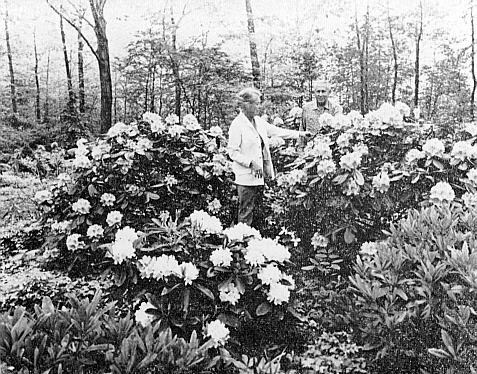
|
|
FIG. 57. Josephine and Leon Heuser in their garden at Indian Run
standing between two R. 'Scintillation'. In front is a blooming R. 'Boule de Niege' flanked by two R. 'Rosamundi'. In the picture below, the Heusers inspect their rock garden at Indian Run, where they were hosts to A.R.S. members during the May 1971 Annual Meeting Tours. |
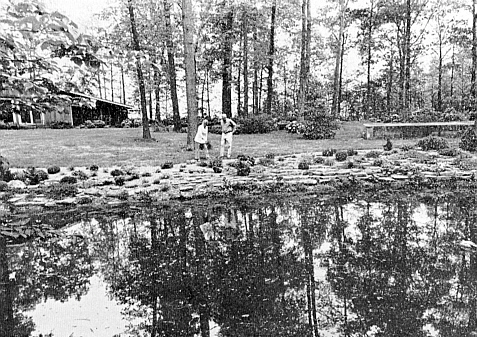
|
As a Society we cannot nor does the Board plan in the foreseeable future to do more than show our real interest and concern over these problems. We should if possible maintain a small fund to give at least token assistance to some project that may be stalled for lack of only a little money to complete some work already started. As you see, this one grant alone exceeds in amount the sum of all the entire membership dues for one year, so we cannot embark on a major project. Such research can be of real value in dollars and cents to every rhododendron grower and especially to commercial nurserymen. The value of plants lost every year due to this disease alone is inestimable.
This is enough talk about things pertaining to money. There are other things that chapters and members are doing around the country that deserve some special mention. One is the establishment of a number of beautiful rhododendron gardens in their respective cities, for the enjoyment of the public and general increase in knowledge about the genus rhododendron. I might mention the one in Stanley Park in Vancouver, B.C. A fine one is being developed in Seattle by that chapter. The Tacoma chapter is taking great pride, justifiably, in the garden at Point Defiance. There is continual improvement of their garden by the Portland chapter. The Rhododendron section at Strybing Arboretum in San Francisco is something we will be looking forward to seeing next year. The Birmingham chapter is engaged in developing a fine facility for beauty, public enjoyment and education. The Azalea chapter has a beautiful site which they will make into a rhododendron park that should be outstanding. I know Dr. Leach was identified with a fine garden project of this kind before he left Brookville. Our Eugene chapter garden, developed with the cooperation of the City Parks Department, has become a tourist attraction. I strongly urge each chapter to become involved in some project of this kind. It is very rewarding to all concerned.

|
|
FIG. 49. Dr. David Leach, the new President
of the American Horticultural Society, Ernesta Ballard, Executive Director of the Pennsylvania Horticultural Society and Dr. Robert L. Ticknor, newly elected President of the A.R.S. taken in the lovely garden of Alfred and Mary Martin, Ambler Pennsylvania. |
I should also mention the contributions Society members have made toward increasing knowledge and beauty by going to foreign lands and bringing in new things. Particularly noteworthy has been the expeditions of Mr. and Mrs. Frank Doleshy to Japan; Mr. and Mrs. Maurice Sumner to bring us the exotic Malaysian species, and Dr. Creech and later Mr. Patrick to Taiwan. Parallel to all this has been the contribution of our beloved Esther Berry, who through her seed exchange has made it possible for many hundreds of people to grow from seed each year species and varieties they otherwise would never have been able to obtain.
I wish to thank the scores of people who have worked countless hours as officers and committee members to make the Society function as a very important organization during the past two years and in particular my warmest thanks to our Secretary, Mrs. Wm. Curtis for her sustained, and dedicated efforts on our behalf. Without so many dedicated people who work untiringly for the cause, the Society would soon perish. I cannot adequately thank you. These two years have been richly rewarding to me personally because of this pleasure of working with so many fine people. I have been greatly honored, and I thank you.
And now I turn the gavel over to Bob Ticknor with every good wish to him, the Society, and each and every one of you for all future time.
